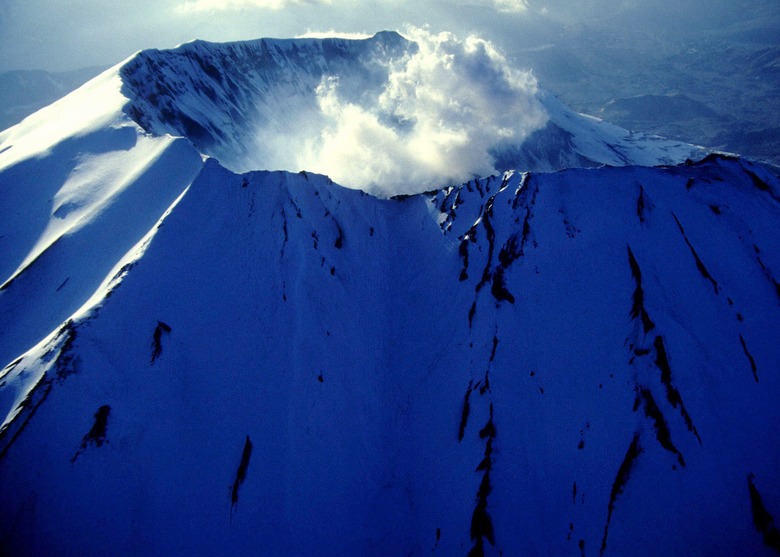How Does A Stratovolcano Erupt?
Generally speaking, the volcanoes that cause the most trouble for humankind are of the kind known as stratovolcanoes or composite volcanoes. Like other types of volcanoes, stratovolcanoes form around vents from which molten rock, or magma, reaches the Earth's surface as lava. They're most common along the planet's great subduction zones, where a tectonic plate plunges beneath another, generating the rock melt necessary to produce volcanic activity. That volcanic activity sometimes takes the form of low-key emission of lava, but often it is much more cataclysmic.
Introducing the Stratovolcano
Introducing
the Stratovolcano
Stratovolcanoes, also called composite volcanoes, are defined by different layers ("stratifications") of material – making them a "composite." Basically, layers of lava flows alternating with ash and rock rubble build the cone. That ashy rubble – "pyroclastic" material derived from lava and rock blasted apart in a violent eruption – would normally be scoured away by erosion, but the lava flows that later cover it provide a protective coating. The middle ground behind steeply accumulating pyroclastics and flattening lava flows produces the broad cone of a typical stratovolcano such as Mount Rainier or Mount Fuji: steeper than a lava-built shield volcano, but gentler than a pyroclastics-built cinder cone.
Explosive and Quiet Eruptions
Explosive and Quiet Eruptions
Stratovolcanoes typically alternate between explosive and non-explosive, or "effusive," eruptions. Those relatively quiet effusive eruptions produce the lava flows, which are more fluid: in other words, less "viscous." (Viscosity is a liquid's resistance to flow.) Along with temperature, the primary factor determining a lava's viscosity is how much silica it contains: more silica means more viscous, a.k.a. less fluid. The stratovolcano's eruptions of more-viscous lava are the explosive ones, ejecting volcanic rock (old lava) and fresh lava violently to produce both airborne pyroclastics, or tephra, and sweeping slides of fragments downslope.
Stratovolcano Lava
Stratovolcano
Lava
The lava that stratovolcanoes produce can range from low-silica basaltic lava to high-silica rhyolitic lava, but the most common kind is midway between those extremes: andesitic. Andesitic lava – named for the Andes Mountains, well stocked with stratovolcanoes – derives from partial melting of the Earth's mantle as happens at subduction zones. The basaltic magma produced rises through continental crust rich in silica, resulting in the intermediate andesitic product.
How Explosive Eruptions Work
How
Explosive Eruptions Work
Magma deep underground exists at a high enough pressure to keep the gases within it in their dissolved state. When magma approaches the surface of the Earth, however, that pressure decreases, and gases can then come out of solution. If there's enough dissolved gas and/or a rapid decrease in pressure, the gases – most importantly water vapor – may escape violently, bursting out in the manner of a soda can opened after being shaken. More-viscous (less-fluid) lava both impedes the escape of gases and can clog the vent or "throat" of a volcano, in both cases ramping up the pressure and leading to more explosive eruptions that may surge forth at velocities exceeding 1,000 miles per hour.
Products of an Explosive Stratovolcano Eruption
Products
of an Explosive Stratovolcano Eruption
The pyroclastic material flung into the air, known as tephra, ranges in size from tiny dustlike particles – ash – to house-sized volcanic bombs. Eruption clouds may rise 25 or more miles into the atmosphere, and they can drop ash (as ashfall) hundreds or thousands of miles downwind. Avalanches of lava froth, rock fragments and hot gases called pyroclastic flows may race swiftly down the slopes of the volcano, often shadowed by pyroclastic surges of gas and ash. One of the most destructive phenomena of a stratovolcano eruption is the lahar: A volcanic mudflow composed of rock fragments and water that funnels at a high speed down drainages. You don't need an eruption, however, to produce a lahar. Heavy precipitation or rapid melting of a volcano's snowpack or glaciers can generate these slurries.
References
- Volcanoes of the Earth; Fred M. Bullard
- The Earth Machine: The Science of a Dynamic Planet; Edmond A. Mathez, James D. Webster
Cite This Article
MLA
Shaw, Ethan. "How Does A Stratovolcano Erupt?" sciencing.com, https://www.sciencing.com/stratovolcano-erupt-8739215/. 22 October 2018.
APA
Shaw, Ethan. (2018, October 22). How Does A Stratovolcano Erupt?. sciencing.com. Retrieved from https://www.sciencing.com/stratovolcano-erupt-8739215/
Chicago
Shaw, Ethan. How Does A Stratovolcano Erupt? last modified August 30, 2022. https://www.sciencing.com/stratovolcano-erupt-8739215/
